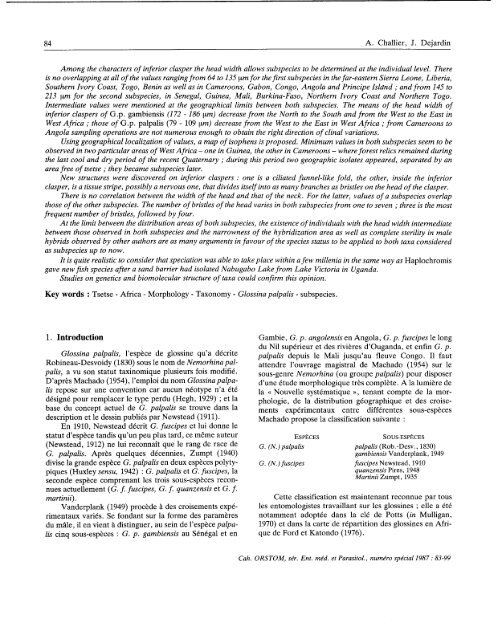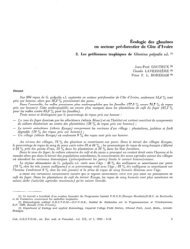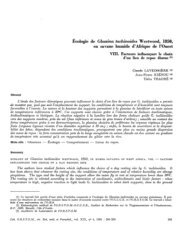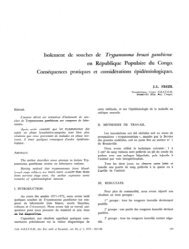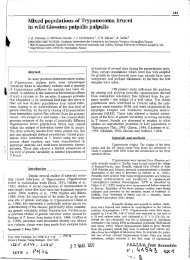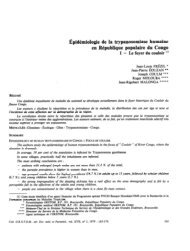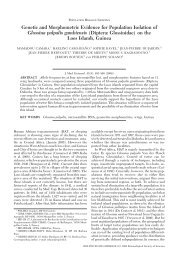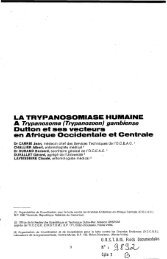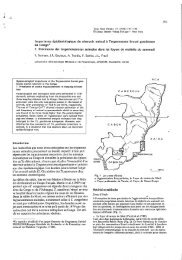Variations morphologiques chez les mâles de Glossina palpalis ...
Variations morphologiques chez les mâles de Glossina palpalis ...
Variations morphologiques chez les mâles de Glossina palpalis ...
Create successful ePaper yourself
Turn your PDF publications into a flip-book with our unique Google optimized e-Paper software.
84 A. Challier, J. DejardinAmong the characters of inferior clasper the head width allows subspecies to be <strong>de</strong>termined at the individual level. Thereis no overlapping at al1 of the values ranging from 64 to 135 pm for the first subspecies in the far-eastern Sierra Leone, Liberia,Southern Ivory Coast, Togo, Benin as well as in Cameroons, Gabon, Congo, Angola and Principe Island ; and from 145 to213 pm for the second subspecies, in Senegal, Guinea, Mali, Burkina-Faso, Northern Ivory Coast and Northern Togo.Intermediate values were mentioned at the geographical limits between both subspecies. The means of the head width ofinferior claspers of G.p. gambiensis (172 - 186 pm) <strong>de</strong>crease from the North to the South and from the West to the East inWest Africa ; those of G.p. <strong>palpalis</strong> (79 - 109 pm) <strong>de</strong>crease from the West to the East in West Africa ; from Cameroons toAngola sampling operations are not numerous enough to obtain the right direction of clinal variations.Using geographical localization of values, a map of isophens is proposed. Minimum values in both subspecies seem to beobserved in two particular areas of West Africa - one in Guinea, the other in Cameroons - where forest relics remained duringthe last cool and dry period of the recent Quaternary ; during this period two geographic isolates appeared, separated by anarea free of tsetse ; they became subspecies later.New structures were discovered on inferior claspers : one is a ciliated funnel-like fold, the other, insi<strong>de</strong> the inferiorclasper, is a tissue stripe, possibly a nervous one, that divi<strong>de</strong>s itself into as many branches as brist<strong>les</strong> on the head of the clasper.There is no correlation between the width of the head and thwt of the neck. For the latter, values of a subspecies overlapthose of the other subspecies. The number of brist<strong>les</strong> of the head varies in both subspecies from one to seven ; three is the mostfrequent number of brist<strong>les</strong>, followed by four.At the limit between the distribution areas of both subspecies, the existence of individuals with the head width intermediatebetween those observed in both subspecies and the narrowness of the hybridization area as well as complete sterility in malehybrids observed by other authors are as many arguments in favour of the species status to be applied to both taxa consi<strong>de</strong>redas subspecies up to now.It is quite realistic to consi<strong>de</strong>r that speciation was able to take place within a few millenia in the same way as Haplochromisgave new fish species after a sand barrier had isolated Nabugabo Lake from Lake Victoria in Uganda.Studies on genetics and biomolecular structure of taxa could confirm this opinion.Key words : Tsetse - Africa - Morphology - Taxonomy - <strong>Glossina</strong> <strong>palpalis</strong> - subspecies.1. Introduction<strong>Glossina</strong> <strong>palpalis</strong>, l’espèce <strong>de</strong> glossine qu’a décriteRobineau-Desvoidy (1830) sous le nom <strong>de</strong> Nemorhina <strong>palpalis</strong>,a vu son statut taxinomique plusieurs fois modifié.D’après Machado (1954), l’emploi du nom <strong>Glossina</strong> <strong>palpalis</strong>repose sur une convention car aucun néotype n’a étédésigné pour remplacer le type perdu (Hegh, 1929) ; et labase du concept actuel <strong>de</strong> G. <strong>palpalis</strong> se trouve dans la<strong>de</strong>scription et le <strong>de</strong>ssin publiés par Newstead (1911).En 1910, Newstead décrit G. fuscipes et lui donne <strong>les</strong>tatut d’espèce tandis qu’un peu plus tard, ce même auteur(Newstead, 1912) ne lui reconnaît que le rang <strong>de</strong> race <strong>de</strong>G. <strong>palpalis</strong>. Après quelques décennies, Zumpt (1940)divise la gran<strong>de</strong> espèce G. <strong>palpalis</strong> en <strong>de</strong>ux espèces polytypiques(Huxley sensu, 1942) : G. <strong>palpalis</strong> et G. fuscipes, lasecon<strong>de</strong> espèce comprenant <strong>les</strong> trois sous-espèces reconnuesactuellement (G. f. fuscipes, G. f. quanzensis et G. f.martinii) .Van<strong>de</strong>rplank (1949) procè<strong>de</strong> à <strong>de</strong>s croisements expérimentauxvariés. Se fondant sur la forme <strong>de</strong>s paramèresdu mâle, il en vient à distinguer, au sein <strong>de</strong> l’espèce<strong>palpalis</strong>cinq sous-espèces : G. p. gambiensis au Sénégal et enGambie, G. p. angolensis en Angola, G. p. fuscipes le longdu Nil supérieur et <strong>de</strong>s rivières d’Ouganda, et enfin G. p.<strong>palpalis</strong> <strong>de</strong>puis le Mali jusqu’au fleuve Congo. Il fautattendre l’ouvrage magistral <strong>de</strong> Machado (1954) sur <strong>les</strong>ous-genre Nemorhina (ou groupe <strong>palpalis</strong>) pour disposerd’une étu<strong>de</strong> morphologique très complète. A la lumière <strong>de</strong>la


